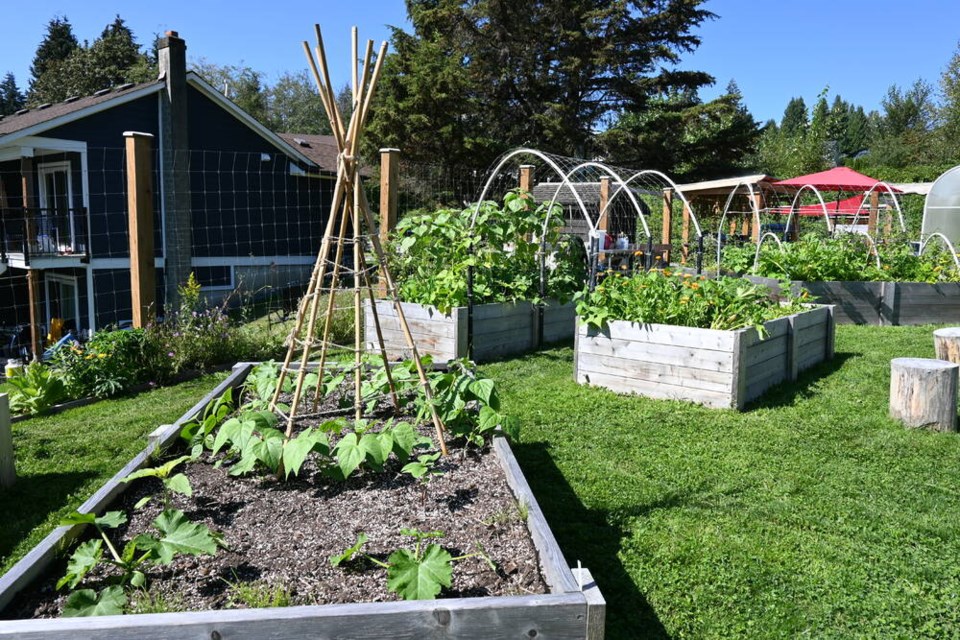The small garden the Tsleil-Waututh Nation began a few short years ago has blossomed into a thriving urban farm.
The Nation, as part of its Ćećǝwǝt lelǝm Helping House, Health and Wellness Program, has been pursuing food sovereignty to create a more sustainable and nutritious diet for its community.
What began with just 17 planters almost a decade ago has expanded to comprise two gardens brimming with produce, and a 40-foot hydroponics container farm that keeps vegetables blooming long through winter.
In recent weeks a smokehouse, built to store up to 200 fish, has been erected opposite the Tsleil-Waututh Cultural and Recreation Centre, ready to be booked for use by members. A second hydroponics unit is in the works and, in just a few weeks time, a chicken coop that sits at the foot of the main garden site will be alive with egg-laying hens.
“From my first year, there were about six people interested in the garden. Now, we’ve got 60 families alone on the reserve getting vegetables, and then we have about 20 to 30 members off reserve that come to get vegetables, too,” said the Tsleil-Waututh Nation’s garden co-ordinator Claudette George.
George has managed the garden since its inception around eight years ago, but it wasn’t until the COVID-19 pandemic, she said, that the community began to seriously invest in producing food for members on Tsleil-Waututh land.
As Andrea Aleck, the Nation’s director of health and wellness, began leading health programs, the two would join forces to find new ways to bring education on nutrition, cooking, food production and distribution to members.
“We have a couple of individuals who have developed programs based on what health challenges people might have, and everybody gets a different customized plan of what we can harvest out of the garden to replenish deficiencies or help conditions,” said Aleck.
Alongside the fruits and vegetables are plants and herbs traditionally used in Indigenous medicines, providing education to members on both nutrition and their own culture.
Tobacco, a spiritual tool used to heal the body and mind, and a plant often put forward as an offering during community ceremonies, is grown in abundance and hung to dry at the garden’s entrance.
Children of the Nation’s siʔáḿθət school learn about the cultural importance of the plants when they visit the facility. They are hands-on with the maintenance and harvesting of the garden, and are regularly joined by young children from the daycare who collect ripe tomatoes and strawberries.
Learning exactly where the food on their plates comes from encourages the students to embrace a more nutritional diet, said George. She remembers past diets of her own family, often processed meals washed down with soda, and said she is grateful for the garden for introducing her to a healthier, more sustainable lifestyle that includes exciting new recipes.
“I knew how to cook with potatoes, because my grandma did it, but beets and kale and eggplant have been really interesting vegetables to bring around the reservation,” she said.
Now, the community has become so involved with the garden that members are requesting fruit trees to plant in their own front lawns. George said the streets within the reserve are starting to look like they did long ago, before colonization, when an orchard of “three different kinds of cherry trees, of plum trees and apple trees,” would bear fruits for the Nation.
“I think one of the most important aspects of this program is creating a lasting legacy, and paying respect to our ancestors, and how they lived on the land and the beauty of going back to growing fruits and vegetables back in our own territory,” said Aleck.
“We need to be respectful of the process and the work that was done long before us. We’re really just picking up the tools that our ancestors left for us.”
Mina Kerr-Lazenby is the North Shore News’ Indigenous and civic affairs reporter. This reporting beat is made possible by the Local Journalism Initiative.



